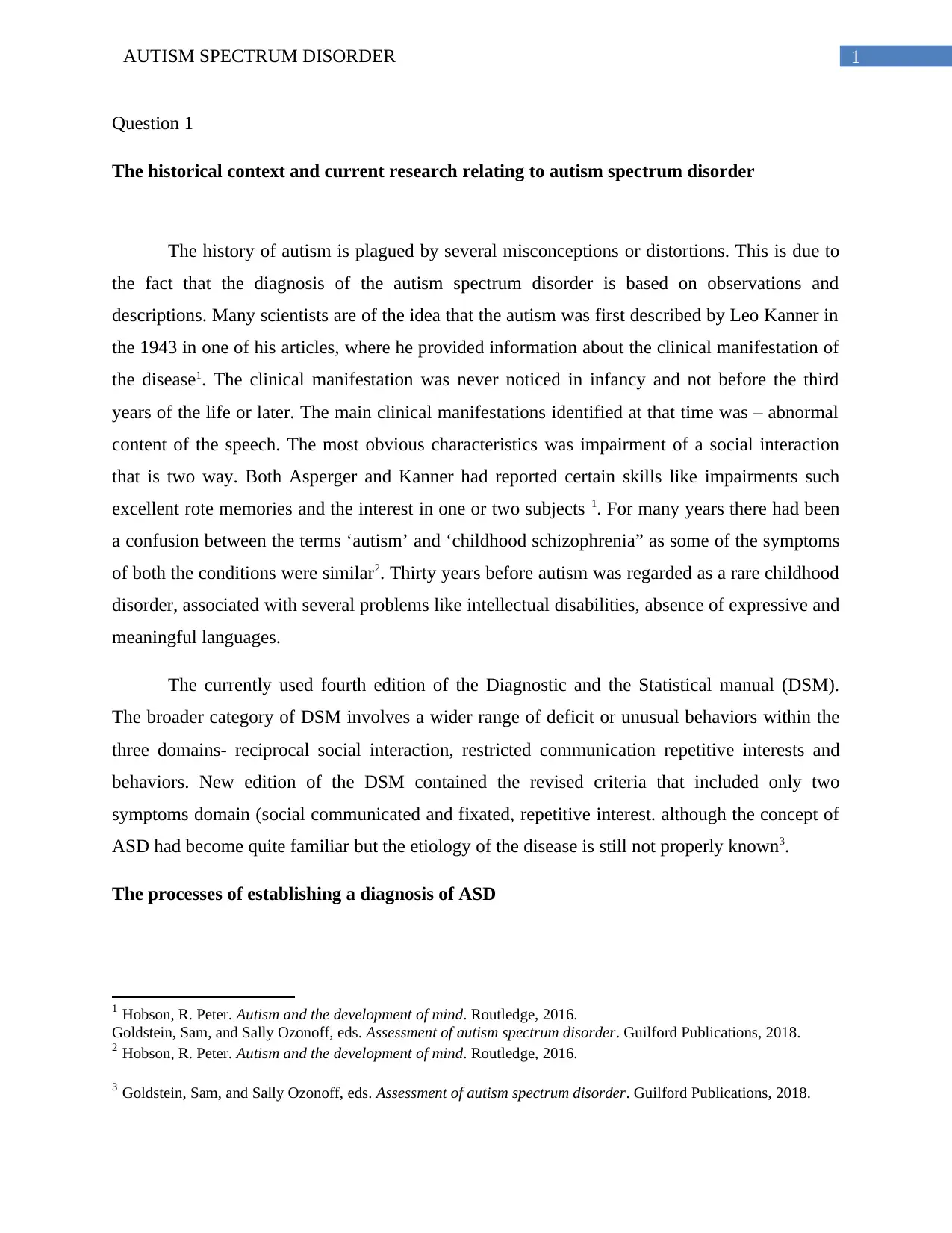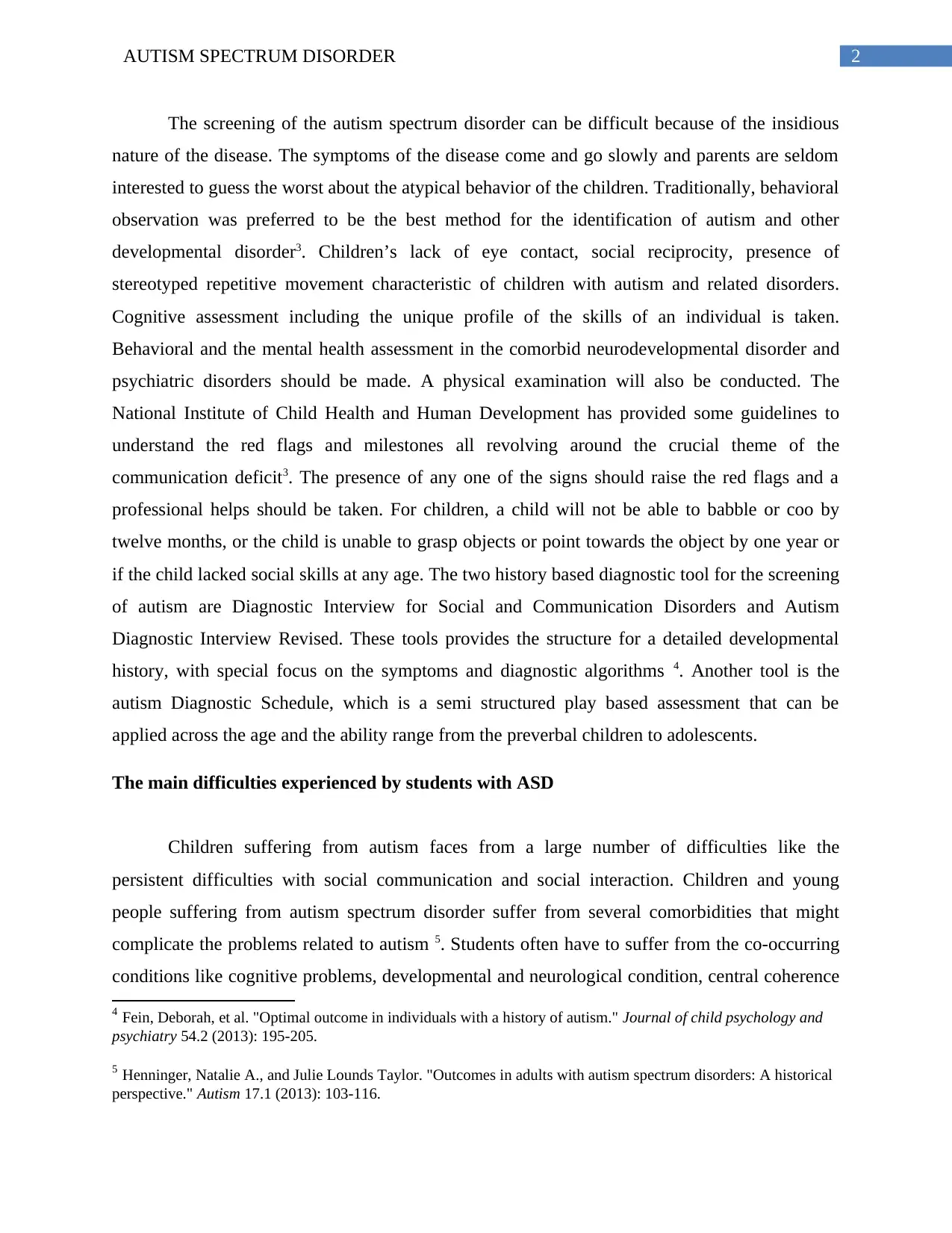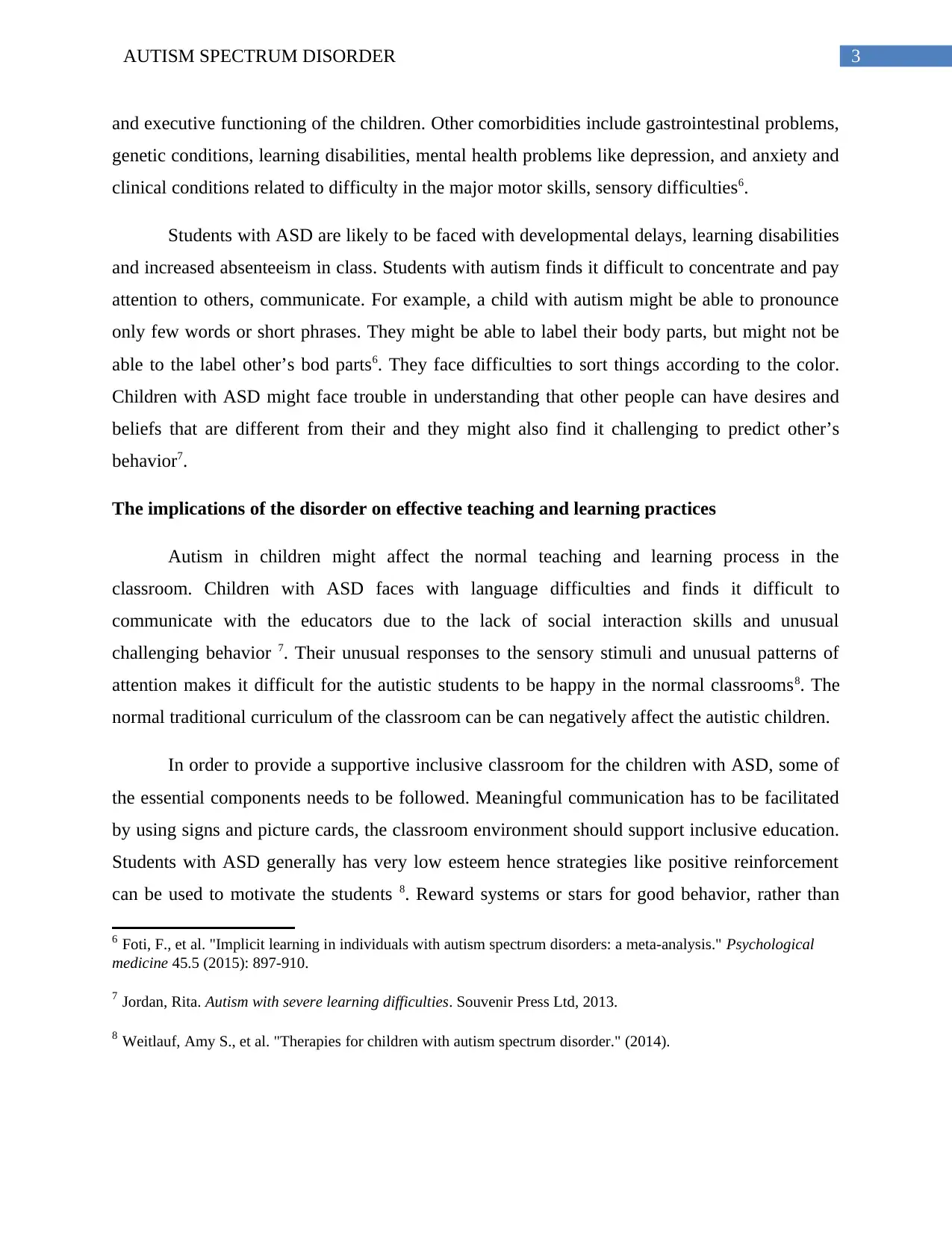Certificate IV in Education Support: Autism Spectrum Disorder Report
VerifiedAdded on 2022/11/14
|6
|1297
|494
Report
AI Summary
This report provides a comprehensive overview of Autism Spectrum Disorder (ASD), beginning with a historical context and tracing the evolution of understanding and diagnosis. It details the diagnostic processes, including screening methods and assessment tools like the Diagnostic Interview for Social and Communication Disorders and the Autism Diagnostic Schedule. The report highlights the difficulties students with ASD face, such as challenges in social communication, learning, and sensory processing, and explores co-occurring conditions that may complicate their experiences. It further discusses the implications of ASD on teaching and learning practices, emphasizing the need for inclusive classroom environments that utilize effective communication strategies, positive reinforcement, and predictable structures. The report underscores the importance of understanding the diverse needs of students with ASD to foster their academic and social success.

Running head: AUTISM SPECTRUM DISORDER
AUTISM SPECTRUM DISORDER
Name of the Student
Name of the university
Author’s note
AUTISM SPECTRUM DISORDER
Name of the Student
Name of the university
Author’s note
Paraphrase This Document
Need a fresh take? Get an instant paraphrase of this document with our AI Paraphraser

1AUTISM SPECTRUM DISORDER
Question 1
The historical context and current research relating to autism spectrum disorder
The history of autism is plagued by several misconceptions or distortions. This is due to
the fact that the diagnosis of the autism spectrum disorder is based on observations and
descriptions. Many scientists are of the idea that the autism was first described by Leo Kanner in
the 1943 in one of his articles, where he provided information about the clinical manifestation of
the disease1. The clinical manifestation was never noticed in infancy and not before the third
years of the life or later. The main clinical manifestations identified at that time was – abnormal
content of the speech. The most obvious characteristics was impairment of a social interaction
that is two way. Both Asperger and Kanner had reported certain skills like impairments such
excellent rote memories and the interest in one or two subjects 1. For many years there had been
a confusion between the terms ‘autism’ and ‘childhood schizophrenia” as some of the symptoms
of both the conditions were similar2. Thirty years before autism was regarded as a rare childhood
disorder, associated with several problems like intellectual disabilities, absence of expressive and
meaningful languages.
The currently used fourth edition of the Diagnostic and the Statistical manual (DSM).
The broader category of DSM involves a wider range of deficit or unusual behaviors within the
three domains- reciprocal social interaction, restricted communication repetitive interests and
behaviors. New edition of the DSM contained the revised criteria that included only two
symptoms domain (social communicated and fixated, repetitive interest. although the concept of
ASD had become quite familiar but the etiology of the disease is still not properly known3.
The processes of establishing a diagnosis of ASD
1 Hobson, R. Peter. Autism and the development of mind. Routledge, 2016.
Goldstein, Sam, and Sally Ozonoff, eds. Assessment of autism spectrum disorder. Guilford Publications, 2018.
2 Hobson, R. Peter. Autism and the development of mind. Routledge, 2016.
3 Goldstein, Sam, and Sally Ozonoff, eds. Assessment of autism spectrum disorder. Guilford Publications, 2018.
Question 1
The historical context and current research relating to autism spectrum disorder
The history of autism is plagued by several misconceptions or distortions. This is due to
the fact that the diagnosis of the autism spectrum disorder is based on observations and
descriptions. Many scientists are of the idea that the autism was first described by Leo Kanner in
the 1943 in one of his articles, where he provided information about the clinical manifestation of
the disease1. The clinical manifestation was never noticed in infancy and not before the third
years of the life or later. The main clinical manifestations identified at that time was – abnormal
content of the speech. The most obvious characteristics was impairment of a social interaction
that is two way. Both Asperger and Kanner had reported certain skills like impairments such
excellent rote memories and the interest in one or two subjects 1. For many years there had been
a confusion between the terms ‘autism’ and ‘childhood schizophrenia” as some of the symptoms
of both the conditions were similar2. Thirty years before autism was regarded as a rare childhood
disorder, associated with several problems like intellectual disabilities, absence of expressive and
meaningful languages.
The currently used fourth edition of the Diagnostic and the Statistical manual (DSM).
The broader category of DSM involves a wider range of deficit or unusual behaviors within the
three domains- reciprocal social interaction, restricted communication repetitive interests and
behaviors. New edition of the DSM contained the revised criteria that included only two
symptoms domain (social communicated and fixated, repetitive interest. although the concept of
ASD had become quite familiar but the etiology of the disease is still not properly known3.
The processes of establishing a diagnosis of ASD
1 Hobson, R. Peter. Autism and the development of mind. Routledge, 2016.
Goldstein, Sam, and Sally Ozonoff, eds. Assessment of autism spectrum disorder. Guilford Publications, 2018.
2 Hobson, R. Peter. Autism and the development of mind. Routledge, 2016.
3 Goldstein, Sam, and Sally Ozonoff, eds. Assessment of autism spectrum disorder. Guilford Publications, 2018.

2AUTISM SPECTRUM DISORDER
The screening of the autism spectrum disorder can be difficult because of the insidious
nature of the disease. The symptoms of the disease come and go slowly and parents are seldom
interested to guess the worst about the atypical behavior of the children. Traditionally, behavioral
observation was preferred to be the best method for the identification of autism and other
developmental disorder3. Children’s lack of eye contact, social reciprocity, presence of
stereotyped repetitive movement characteristic of children with autism and related disorders.
Cognitive assessment including the unique profile of the skills of an individual is taken.
Behavioral and the mental health assessment in the comorbid neurodevelopmental disorder and
psychiatric disorders should be made. A physical examination will also be conducted. The
National Institute of Child Health and Human Development has provided some guidelines to
understand the red flags and milestones all revolving around the crucial theme of the
communication deficit3. The presence of any one of the signs should raise the red flags and a
professional helps should be taken. For children, a child will not be able to babble or coo by
twelve months, or the child is unable to grasp objects or point towards the object by one year or
if the child lacked social skills at any age. The two history based diagnostic tool for the screening
of autism are Diagnostic Interview for Social and Communication Disorders and Autism
Diagnostic Interview Revised. These tools provides the structure for a detailed developmental
history, with special focus on the symptoms and diagnostic algorithms 4. Another tool is the
autism Diagnostic Schedule, which is a semi structured play based assessment that can be
applied across the age and the ability range from the preverbal children to adolescents.
The main difficulties experienced by students with ASD
Children suffering from autism faces from a large number of difficulties like the
persistent difficulties with social communication and social interaction. Children and young
people suffering from autism spectrum disorder suffer from several comorbidities that might
complicate the problems related to autism 5. Students often have to suffer from the co-occurring
conditions like cognitive problems, developmental and neurological condition, central coherence
4 Fein, Deborah, et al. "Optimal outcome in individuals with a history of autism." Journal of child psychology and
psychiatry 54.2 (2013): 195-205.
5 Henninger, Natalie A., and Julie Lounds Taylor. "Outcomes in adults with autism spectrum disorders: A historical
perspective." Autism 17.1 (2013): 103-116.
The screening of the autism spectrum disorder can be difficult because of the insidious
nature of the disease. The symptoms of the disease come and go slowly and parents are seldom
interested to guess the worst about the atypical behavior of the children. Traditionally, behavioral
observation was preferred to be the best method for the identification of autism and other
developmental disorder3. Children’s lack of eye contact, social reciprocity, presence of
stereotyped repetitive movement characteristic of children with autism and related disorders.
Cognitive assessment including the unique profile of the skills of an individual is taken.
Behavioral and the mental health assessment in the comorbid neurodevelopmental disorder and
psychiatric disorders should be made. A physical examination will also be conducted. The
National Institute of Child Health and Human Development has provided some guidelines to
understand the red flags and milestones all revolving around the crucial theme of the
communication deficit3. The presence of any one of the signs should raise the red flags and a
professional helps should be taken. For children, a child will not be able to babble or coo by
twelve months, or the child is unable to grasp objects or point towards the object by one year or
if the child lacked social skills at any age. The two history based diagnostic tool for the screening
of autism are Diagnostic Interview for Social and Communication Disorders and Autism
Diagnostic Interview Revised. These tools provides the structure for a detailed developmental
history, with special focus on the symptoms and diagnostic algorithms 4. Another tool is the
autism Diagnostic Schedule, which is a semi structured play based assessment that can be
applied across the age and the ability range from the preverbal children to adolescents.
The main difficulties experienced by students with ASD
Children suffering from autism faces from a large number of difficulties like the
persistent difficulties with social communication and social interaction. Children and young
people suffering from autism spectrum disorder suffer from several comorbidities that might
complicate the problems related to autism 5. Students often have to suffer from the co-occurring
conditions like cognitive problems, developmental and neurological condition, central coherence
4 Fein, Deborah, et al. "Optimal outcome in individuals with a history of autism." Journal of child psychology and
psychiatry 54.2 (2013): 195-205.
5 Henninger, Natalie A., and Julie Lounds Taylor. "Outcomes in adults with autism spectrum disorders: A historical
perspective." Autism 17.1 (2013): 103-116.
⊘ This is a preview!⊘
Do you want full access?
Subscribe today to unlock all pages.

Trusted by 1+ million students worldwide

3AUTISM SPECTRUM DISORDER
and executive functioning of the children. Other comorbidities include gastrointestinal problems,
genetic conditions, learning disabilities, mental health problems like depression, and anxiety and
clinical conditions related to difficulty in the major motor skills, sensory difficulties6.
Students with ASD are likely to be faced with developmental delays, learning disabilities
and increased absenteeism in class. Students with autism finds it difficult to concentrate and pay
attention to others, communicate. For example, a child with autism might be able to pronounce
only few words or short phrases. They might be able to label their body parts, but might not be
able to the label other’s bod parts6. They face difficulties to sort things according to the color.
Children with ASD might face trouble in understanding that other people can have desires and
beliefs that are different from their and they might also find it challenging to predict other’s
behavior7.
The implications of the disorder on effective teaching and learning practices
Autism in children might affect the normal teaching and learning process in the
classroom. Children with ASD faces with language difficulties and finds it difficult to
communicate with the educators due to the lack of social interaction skills and unusual
challenging behavior 7. Their unusual responses to the sensory stimuli and unusual patterns of
attention makes it difficult for the autistic students to be happy in the normal classrooms8. The
normal traditional curriculum of the classroom can be can negatively affect the autistic children.
In order to provide a supportive inclusive classroom for the children with ASD, some of
the essential components needs to be followed. Meaningful communication has to be facilitated
by using signs and picture cards, the classroom environment should support inclusive education.
Students with ASD generally has very low esteem hence strategies like positive reinforcement
can be used to motivate the students 8. Reward systems or stars for good behavior, rather than
6 Foti, F., et al. "Implicit learning in individuals with autism spectrum disorders: a meta-analysis." Psychological
medicine 45.5 (2015): 897-910.
7 Jordan, Rita. Autism with severe learning difficulties. Souvenir Press Ltd, 2013.
8 Weitlauf, Amy S., et al. "Therapies for children with autism spectrum disorder." (2014).
and executive functioning of the children. Other comorbidities include gastrointestinal problems,
genetic conditions, learning disabilities, mental health problems like depression, and anxiety and
clinical conditions related to difficulty in the major motor skills, sensory difficulties6.
Students with ASD are likely to be faced with developmental delays, learning disabilities
and increased absenteeism in class. Students with autism finds it difficult to concentrate and pay
attention to others, communicate. For example, a child with autism might be able to pronounce
only few words or short phrases. They might be able to label their body parts, but might not be
able to the label other’s bod parts6. They face difficulties to sort things according to the color.
Children with ASD might face trouble in understanding that other people can have desires and
beliefs that are different from their and they might also find it challenging to predict other’s
behavior7.
The implications of the disorder on effective teaching and learning practices
Autism in children might affect the normal teaching and learning process in the
classroom. Children with ASD faces with language difficulties and finds it difficult to
communicate with the educators due to the lack of social interaction skills and unusual
challenging behavior 7. Their unusual responses to the sensory stimuli and unusual patterns of
attention makes it difficult for the autistic students to be happy in the normal classrooms8. The
normal traditional curriculum of the classroom can be can negatively affect the autistic children.
In order to provide a supportive inclusive classroom for the children with ASD, some of
the essential components needs to be followed. Meaningful communication has to be facilitated
by using signs and picture cards, the classroom environment should support inclusive education.
Students with ASD generally has very low esteem hence strategies like positive reinforcement
can be used to motivate the students 8. Reward systems or stars for good behavior, rather than
6 Foti, F., et al. "Implicit learning in individuals with autism spectrum disorders: a meta-analysis." Psychological
medicine 45.5 (2015): 897-910.
7 Jordan, Rita. Autism with severe learning difficulties. Souvenir Press Ltd, 2013.
8 Weitlauf, Amy S., et al. "Therapies for children with autism spectrum disorder." (2014).
Paraphrase This Document
Need a fresh take? Get an instant paraphrase of this document with our AI Paraphraser

4AUTISM SPECTRUM DISORDER
crosses for bad behavior has to be given. It is important to create an environment that is
predictable, meaningful and manageable for the students.
crosses for bad behavior has to be given. It is important to create an environment that is
predictable, meaningful and manageable for the students.

5AUTISM SPECTRUM DISORDER
References
Camarata, S. (2014). Early identification and early intervention in autism spectrum disorders:
Accurate and effective?. International Journal of Speech-Language Pathology, 16(1), 1-10.
Fein, Deborah, et al. "Optimal outcome in individuals with a history of autism." Journal of child
psychology and psychiatry 54.2 (2013): 195-205.
Foti, F., et al. "Implicit learning in individuals with autism spectrum disorders: a meta-analysis."
Psychological medicine 45.5 (2015): 897-910.9
Goldstein, Sam, and Sally Ozonoff, eds. Assessment of autism spectrum disorder. Guilford
Publications, 2018.
Henninger, Natalie A., and Julie Lounds Taylor. "Outcomes in adults with autism spectrum
disorders: A historical perspective." Autism 17.1 (2013): 103-116.
Hobson, R. Peter. Autism and the development of mind. Routledge, 2016.
Jordan, Rita. Autism with severe learning difficulties. Souvenir Press Ltd, 2013.
Weitlauf, Amy S., et al. "Therapies for children with autism spectrum disorder." (2014).
9
References
Camarata, S. (2014). Early identification and early intervention in autism spectrum disorders:
Accurate and effective?. International Journal of Speech-Language Pathology, 16(1), 1-10.
Fein, Deborah, et al. "Optimal outcome in individuals with a history of autism." Journal of child
psychology and psychiatry 54.2 (2013): 195-205.
Foti, F., et al. "Implicit learning in individuals with autism spectrum disorders: a meta-analysis."
Psychological medicine 45.5 (2015): 897-910.9
Goldstein, Sam, and Sally Ozonoff, eds. Assessment of autism spectrum disorder. Guilford
Publications, 2018.
Henninger, Natalie A., and Julie Lounds Taylor. "Outcomes in adults with autism spectrum
disorders: A historical perspective." Autism 17.1 (2013): 103-116.
Hobson, R. Peter. Autism and the development of mind. Routledge, 2016.
Jordan, Rita. Autism with severe learning difficulties. Souvenir Press Ltd, 2013.
Weitlauf, Amy S., et al. "Therapies for children with autism spectrum disorder." (2014).
9
⊘ This is a preview!⊘
Do you want full access?
Subscribe today to unlock all pages.

Trusted by 1+ million students worldwide
1 out of 6
Related Documents
Your All-in-One AI-Powered Toolkit for Academic Success.
+13062052269
info@desklib.com
Available 24*7 on WhatsApp / Email
![[object Object]](/_next/static/media/star-bottom.7253800d.svg)
Unlock your academic potential
Copyright © 2020–2025 A2Z Services. All Rights Reserved. Developed and managed by ZUCOL.





